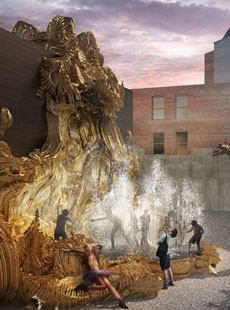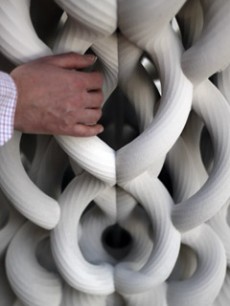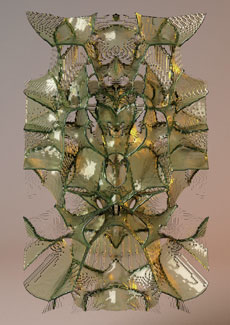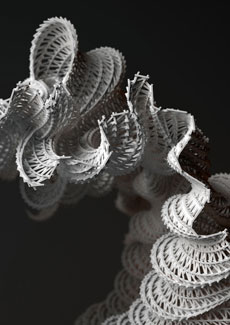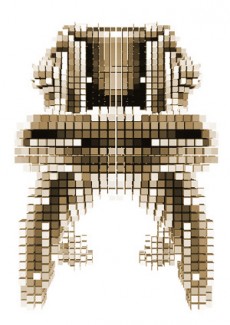
Projects
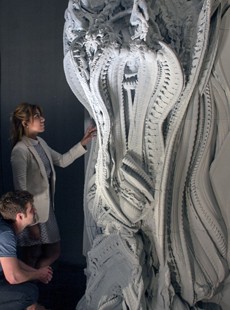
Arabesque Wall
The Arabesque Wall was designed and created by Benjamin Dillenburger and Michael Hansmeyer in collaboration with Design Exchange, Toronto for the 3DXL exhibition. Continue reading
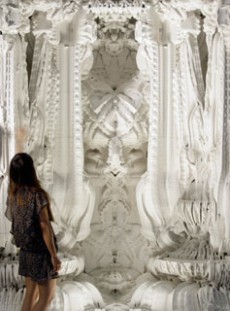
Grotto
3D Printing Architecture.
This project by Michael Hansmeyer and Benjamin Dillenburger will launch July 22nd, 2013. Continue reading
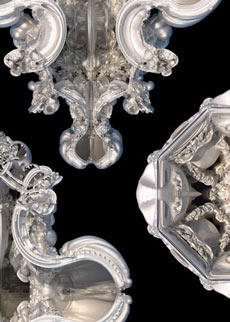
Domes
A series of domes is designed by using a dynamic process entitled mesh grammars. (with Michael Hansmeyer) Continue reading
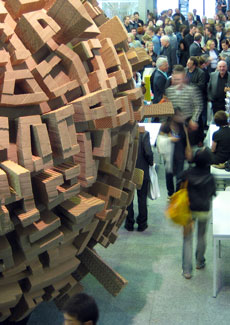
Stadtigel
It is a city on a sphere, but not necessarily a global city, maybe a city globe: endless – or better – beginningless. (with Kaisersrot)
It is a city on a sphere, but not necessarily a global city, maybe a city globe: endless – or better – beginningless. There is neither periphery nor center. The city’s openness is simultaneously based on its seclusion. Once within one can never leave again. The city has a specific form; its physical presence is obvious. Nevertheless, the city can never be experienced in its totality. There is no outside vantage point from which all of the 80 square meters of city surface can be coherently perceived. Equally due to its curvature, the city can never be represented by an urban plan. Its street layout is almost impossible to be drawn correctly on a plain surface. Therefore, not a plan but a set of deliberately chosen rules originate specific localities and connect the city’s infrastructure to its built mass and distribution of program. Thereby, the sphere’s surface forfeits its former homogeneity, gets ruptured and spatially differentiated. Although already being aware of the impossibility of such attempt, the spectator wants to follow the streets all over the globe. However, the track will be lost, at the latest, when the streets bend over the top or the bottom of the sphere. Despite such partial cognition, the spectator is still convinced that the city’s network is continuous. This belief makes you walk around this object. And yes, not one single dead end street can be found.
Together with KAISERSROT (Matthias Bernhard, Markus Braach, Benjamin Dillenburger, Oliver Fritz, Alex Lehnerer) and Tom Pawlofsky. Continue reading

Dynamic Shapegrammars
A grammar of replacement rules creates a network structure that is adapted by a spring system. Continue reading
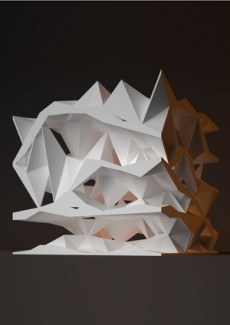
Oblique Circulation
What if we could imagine a journey through a building, a promenade architecturale, and let the computer arrange this storyline for us?
Continue reading

Zurich SOM
A self organizing map (SOM) is a model of a artificial neural network developed by the Finnish professor Teuvo Kohonen. A SOM is used to rearrange the plots of the inner city of Zurich so that similar plots are close to each other. Continue reading

16.000 flats
An algorithm generates an endless alphabet of floorplan-variations. The resulting plans are clustered by similarity. Topological and geometrical properties are iterated, from 1-room apartments to 4-room apartments.The resulting plans are sorted by a self organising map (SOM) to cluster similar compositions together. Continue reading

Emerging Typologies
An agent-based model is introduced for a self-organized building distribution in a predefined environment. Agents are simulating architects, constantly redesigning and rearranging the houses over time. Each agent incorporates as behavior his own simple evolutionary strategy to optimize the layout … Continue reading

Space Index
An information retrieval system for parcels is introduced that not only allows searching for specific attributes, but also includes properties of shape and context of the building plots.
Increasingly, digital architectural data will become available through information technology. Yet until now, there were no satisfying methods to query this data for architectural purposes. An information retrieval system for parcels is introduced that not only allows searching for specific attributes, but also includes properties of shape and context of the building plots. An automatically generated index stores the relevant spatial properties as normalized bitmap images on several layers. When a query is started, only this index has to be queried and not the complete database. The search process can be controlled through a graphical interface that incorporates the user’s sketches. The retrieved parcels are presented as a sorted list of vector drawings including their contained buildings. With the simplified access to these case-studies, quality and efficiency of the architectural design process could be increased. Continue reading

Flib: Topological Floorplan Library
A library of floor-plans with over 1000 appartments of existing houses. The database allows complex search-queries by topological and geometrical properties, concerning building-elements, rooms, and organisation. Continue reading

Bent
One mile steeltube pavilion.
Steeltube as material has an enormous capaticity for construction. CNC bending machines have the ability to deform materials in three-dimensions, rather than the popular CNC techniques for architectural design, which use subtractive methods like laser-cutting and milling. The research examines the potential of a digital deforming process of CNC-Bending. During 3 months the Students developed a concept, programmed the software for generating the structure and produced three prototyps shown at an exhitbion. Continue reading

Digital Catenary
Computational domes. The design is generated with shape grammars. The construction dynamically shifts to a static equilibrium. Continue reading
